| 1 |
 |
Page 1
“...Published by the Chefoo Schools Association
ASSOCIATION
The Chefoo Magazine
Centennial Issue
FEATURED IN ISSUE THIS
Many Faces of the 3
Chefoo Magazine
The First Decade 7
Between the Wars 13
During World War II 20
Post WWII China Years 27
Post China Schools & 33
Hostels
Chefusians Return to 40
China
In Memoriam - The
Headmasters 45
The year 2008 marks the 100th birthday of the Chefoo Schools Association!! This is a remarkable achievement, and we are still going strong, with active branches in Australia, New Zealand, North America, and the United Kingdom, and members residing within these jurisdictions, and many other places throughout the world.
To commemorate our 100 years, this entire special issue draws from items featured in The Chefoo Magazine since its inception in 1908. Read, and enjoy!...”
|
|
| 2 |
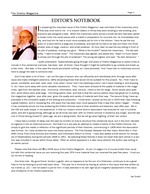 |
Page 2
“...how endearing the Chefoo Schools were to their students and teachers, year after year. We in the CSA are quite unique, in my experience, in that our mission school alumni association has endured for over a hundred years, and still is going strong, although as we all know very well, with no Chefoo schools in existence any longer, and the last one in China having closed 57 years ago, we are a dying breed. But we will go down fighting, of that I am certain.
I have had a number of ideas over the past six months on how to structure this centennial issue, but in the end I decided to organize it into an historical account. Not that it is in any way an attempt to create a history of the Chefoo Schools, but simply to give the reader a reflection of the significant periods of their histories, commencing in 1908 when the Association was formed. So I have divided the issue into these sections: The First Decade; Between the War Years; World War II; Post WWII China; Post China Schools and Hostels; and...”
|
|
| 3 |
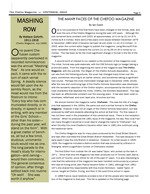 |
Page 3
“...years, sometimes returning to an earlier version, and sometimes taking a significant new course. Perhaps the most memorable change was in December 1935, shortly after the new and continuing logo of the Chefoo Schools Association was developed, with the wonderful depiction of the Chefoo dolphin, accompanied by the block of Chinese characters that depicted the motto, Chefoo, Old Scholars Association. This logo has been an affectionate constant over the ensuing years. It has also been used on envelopes, letterhead, and even lapel pins, brooches and ties.
We should mention the magazine name, Chefusian. This was the title of a magazine that appeared in the 1930s, the same size and a similar format to the Chefoo Magazine. However it was not an organ of the Chefoo Schools Association, but was produced by staff and students attending the school at that time. For this reason it has not been used in the preparation of this centennial issue. There is one exception, however. When he produced the 1991 issue...”
|
|
| 4 |
 |
Page 4
“...The Chefoo Magazine
CENTENNIAL ISSUE
Page 4
EDITORS OF THE CHEFOO MAGAZINE
Years as Editor Names Years at Chefoo Schools
1908-1917 Horace W. Hunt 1896-1900
1918-1921 Gertie (McCarthy) Chalice 1888-1892
1921-1923 Amy Gladys Willett 1902-1910
1923-1942 Howard F. Joyce 1909-1915
1943-1947 John G. Weller 1922-1930
1947-1953 John S. Hirst 1928-1934
1953-1961 Doris E. Rouse 1921-1932
1961-1962 Jean Pearce 1947-1951
1962-1971 Jean Pearce &
Eva (Cook) Nicholson 1927-1937
1971-1984 Isabel Taylor 1911-1922; Staff 1934-1966
1984-1991 Francis Rob Joyce 1946-1951
1991-2002 Dorothy (Cox) Chadborn 1948-1951
2003- Ian Grant 1946-1950
THE ORGAN OF
THE CHEFOO SCHOOLS ASSOCIATION....”
|
|
| 5 |
 |
Page 5
“...The Chefoo Magazine — CENTENNIAL ISSUE
Page 5...”
|
|
| 6 |
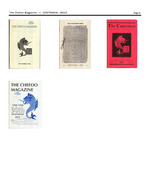 |
Page 6
“...The Chefoo Magazine
CENTENNIAL ISSUE
Page 6
THE CHEFOO MAGA2NE
DECEMBER 1986
________
CHRISTMAS W8S
THE CHEFOO
MAGAZINE...”
|
|
| 7 |
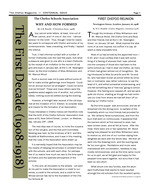 |
Page 7
“...means for the formation of an Association.
Those interested in Chefoo history will therefore note that the birth of the Chefoo Schools’ Association took place at 91 New Oxford Street, London, on Wednesday, January 29th, 1908.
The next step was of course, to invite the cooperation of the old girls, and the first joint Committee Meeting was held, by the kindness of W.D. and Mrs. Mudditt at Walthomstow, and it was in this meeting that the rules of the Association were drawn up. . .
It is earnestly hoped that the Association may be the means of keeping old scholars in constant touch with the schools, and with each other, for perhaps few of us realize how much we owe to the time spent at Chefoo and the splendid atmosphere of the schools.
To this end, all shoulders to the wheels. Let each do his part to make the Association a credit to ourselves, a credit to the schools, and a credit to Him, Whose service has led to the foundation of the Chefoo Schools.♦
FIRST CHEFOO REUNION
Newington Green, London...”
|
|
| 8 |
 |
Page 8
“...thread is produced in larger quantities in Germany. It is then sent to Taiwan and various parts of China to be made into nets, taking advantage of cheap labour and it is re-exported to the West.4
(Continued from page 7)
al training received at the C.I.M. Schools, and it is only right that the masters and mistresses should know this, in order that they might be encouraged to go on in this branch of their work.
As a result of the reunion the C.S.A. was formed, and the Magazine, in which this article appears, shows that we all hope it will be a permanent institution; and there is no reason why it should not, if only the scholars, past, present and future, will do all they can to make it a gigantic success. W.D. Mudditt ♦
THE BAflflE
Chefoo Magazine, October 1911
e are at last able to show an illustration of the badge which
has been under consideration for so long, and hope it will meet with the approval of all members. The above illustration is the actual size of the badge, which is strongly...”
|
|
| 9 |
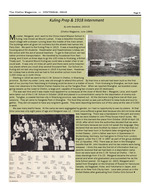 |
Page 9
“...The Chefoo Magazine
CENTENNIAL ISSUE
Page 9
Kuling Prep & 1918 Internment
By John Kauderer, 1913-23
[Chefoo Magazine, June 1988]
My sister, Margaret, and I went to the China Inland Mission School in Kuling, now known as Mount Lushan. It was a beautiful mountain resort village with a stream running down the middle of the main street. The buildings were all given lot numbers but the streets had names like Fairy Glen. We went to the Kuling Prep in 1913. It was a boarding school housing about 50 students. Headmaster and Headmistress Lindsay ran the school with the aid of several teachers. To get to that school, we had rather primitive transportation. We travelled by houseboat from Nan-chang, and it took us three days to go the 100 miles to Kiukiang, a British Treaty port. To ascend Mount Kuling we could take a sedan chair or we could walk. It was only 14 miles all uphill and there were some treacherous places where you could drop several thousand feet. Our School on Kuling did not last very...”
|
|
| 10 |
 |
Page 10
“...The Chefoo Magazine
CENTENNIAL ISSUE
Page 10
WAS CHEFOO SCHOOL WORTH IT?
By Marjorie (Lawson) Lugsdin
Chefoo Magazine, December 1956
Did the years at Chefoo affect the credit or the debit side of the balance sheet of preparedness for the things I have done since leaving school in 1923? I had not actually sat down to an accounting before, and probably would not have done so now, had it not been for a little lady-like blackmail on the part of the North American secretary, who wanted words for the spaces she had promised to fill in the Chefusian (Chefoo Magazine).
For my course at university and the career I was planning to follow—teaching—Chefoo was very good. Our English, history and language studies were well above par. Although we had no science standing, that defect was remedied for later generations. Moreover, we were encouraged to read, and read, and read. That also was good. The only drawback was that we rather got the impression that nothing worthwhile had been written since the days...”
|
|
| 11 |
 |
Page 11
“...The Chefoo Magazine
CENTENNIAL ISSUE
Page 11
RECORD SWIM
By “A Chefoo Chefooite”
(Chefoo Magazine, February 1910)
It was on Friday afternoon that a record long swim was accomplished. The longest swim is usually two miles, and in some instances three, but to the Bluff—impossible! No! it is possible, as was seen on the eventful day of 20th August, 1909.
Two cups were offered to the boys for the longest swim (which was a great incentive), by Messrs. Saunders and Soper, of the Telegraph Company, to whom due thanks was given.
All the rowing boats available were towed over to the Bluff by Cornabe, Eckford & Co.’s launch, kindly lent for the occasion, and at 3 p.m. six boys dived from the stern of the launch a short distance from the shore. Each competitor was accompanied by a small boat full of boys, eager to help and encourage (of course they didn’t help, but I feel sure wanted to) their charge. Fortunately no steamers interrupted the proceedings, and all went well for some time till one boy...”
|
|
| 12 |
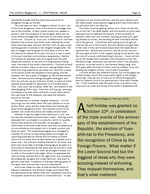 |
Page 12
“...The Chefoo Magazine
CENTENNIAL ISSUE
Page 12
reluctantly thought that the best policy would be to straighten things up himself.
The pilot was our hero. Imagine a stretch of river, one of the most dangerous rivers in the world for pilotage, and one of the trickiest. In fact—pilots correct me, please—I doubt if, with the exception of the Hooghly, there can be more difficult pilotage than that even on the lower stretch of the river. Conjure up, if you can, a difference of 100 feet between the summer and winter level, altering the conditions every few days, and you will then, with us, give a well-earned guerdon of praise to the Yangtze Gorges pilot. His pay is meager, and he gulps his food down in five or ten minutes as he stands at his post, but he is a man in spite of his poor coat and commonplace appearance. Behind him stands an assistant, who at a signal from the pilot keeps the trackers, at the end of a long bamboo towing rope, informed of the chief’s instructions. The pilot himself stands...”
|
|
| 13 |
 |
Page 13
“...of whom were present.
The entire Boys’ and Girl’ Schools were there, and some of the “Prepites.” It was an occasion that will long live in the memory of all who took part.4
CHEFUSIANORUM SIGNUM
Signed “M”
Chefoo Magazine, March 1937
Although it is time the Chefoo whale justified the faith of his believers by putting in an appearance, it is a pity that he died before arriving. Many Chefusians have scoffed at the idea of having a whale as an emblem; some of them had nev
er seen a whale at Chefoo, and they could not realize how intimately whales were connected with the dear old school. There seems to be a family of whales who have Chefoo under their patronage. It is for them a sort of hereditary
burying-ground, and, whenever they hear the last clear call, it is to the tides that run into Chefoo that they resign themselves.
Whales are long-lived animals; thus only once in twenty years is one borne to rest in Chefoo. The last one arrived just before I went to the kindergarten. I met those who...”
|
|
| 14 |
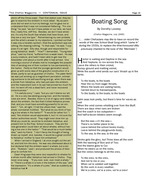 |
Page 14
“...mother to have him embalmed.”
When I arrived in England, I at once sought out the artist, and told him the story. He was very distressed about it, but declared that the emblem wasn’t a whale, but a dolphin. “Rubbish,” said I, and produced the photos of Adolphus to confute him.
Dawn King says they were very respectful to whales for a whole month after Adolphus had arrived in Chefoo. They never once sang: “If you ever, ever, ever meet a whale,” or “There’s a whale in a hole in the bottom of the sea,” and the expression, “It’s a whale of a joke,” died as suddenly as Adolphus had.4
Boating Song
By Dorothy Loosley
(Chefoo Magazine, July 1945)
(... older Chefusians may like to have on record the words of the new School Boat Song which “came in” during the 1930s, to replace the time-honoured ditty previously chanted to the tune of the “Mermaid.”)
Hector is waiting and Daphne in the sea
And Neptune, to row across the bay.
Leave the others to their cricket,
Bumpy ground and matting wicket,
While...”
|
|
| 15 |
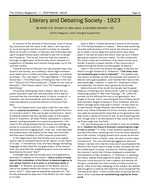 |
Page 15
“...The Chefoo Magazine
CENTENNIAL ISSUE
Page 15
Literary and Debating Society -1923
By Alister H.G. Grosart (in later years, a Canadian Senator—IG)
(Chefoo Magazine, 1923, Shanghai Supplement)
An account of the activities of this Society, must of necessity commence with the name of Mr. Bazire, who has done so much during the last five months to further its interests. When he arrived in Chefoo, in February, the Committee hearing of his great literary talent, decided to ask him to accept the Presidency. This he did, and from that time started a thorough reorganization of the Society, which resulted in a programme of Debates and Lectures being drawn up for the next few months.
Towards the end of February the new president was introduced to the Society, at a meeting in which eight members were called upon to make impromptu speeches, on subjects as follows: “Our Late head”—“The Ideal Master”—“The Ideal School Boy”—“The Effeminacy of Parting the Hair in the Centre”—“Second Form Reminiscences”—“Sweet...”
|
|
| 16 |
 |
Page 16
“...The Chefoo Magazine
CENTENNIAL ISSUE
Page 16
AUGUST 1928
THESE GATES WERE
PRESENTED TO THE SCHOOL
IN MEMORY OF
PAUL J. RILEY
AND
ALFRED I. ANDREW
TWO OF THE OLD BOYS WHO
LAID DOWN THEIR LIVES IN
THE GREAT WAR
The families of the two Old Boys erected
the gates in their memory.
THE DEDICATION OF THE NEW GATES
(Chefoo Magazine, December 1929)
These gates, which now command the entry from the Beach Road to the B.S. field, were erected during the latter half of the last term. The Dedication Service, conducted by Mr. Coulthard, was held on the 22nd of August, and was attended by a large number, including all the scholars staying at the schools.
The meeting commenced with the singing of a hymn, “0 God, our help in ages past,” after which Mr. Coulthard read the 145th Psalm. Then Mr. McCarthy read the letter from the donors and made his speech, as given below:
“The beautiful gates, which have been given to the Boys’ School, like all its other property, belong to the China Inland Mission, and a record...”
|
|
| 17 |
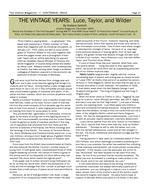 |
Page 17
“...masters, which few schools anywhere could equal or surpass.
Barely a hundred “boarders”, plus a handful of lads from local families, made up the boys’ School roster of that day. Yet from this small company of four decades ago the world was to hear from several in quite ringing terms and it will go on hearing from them for some years to come.
This pre-World War I generation of Chefusians, moreover, gave its full share of young men to the fighting services of Britain, the Commonwealth countries and the United States. It paid its generous quota of supreme sacrifice in the long roll of casualties that stretched from first Ypres and the Somme to beaches of Normandy, the Rhine crossings and the landings of the Pacific. The names of Terrence McCarthy, Henry Whittlesey and Theodore Emslie stand out, in my own memory, among a much larger group of gallant Chefoo graduates who underwrote their devotion to freedom with their lives.
Since boys from the British Isles predominated at Chefoo, and also because...”
|
|
| 18 |
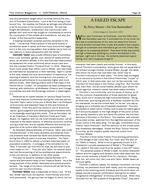 |
Page 18
“...out, by two seconds, over Thornton for third place in the Chefoo Long Run. But Thornton was, even then, the all-round healthy athlete upon which his whole vigorous, meteoric career has been safely founded.
Thornton’s non-conformity, and his sense of drama, so often the common characteristics of those destined for greatness, burst out in occasional high-humoured flashes. Being an American, and having become a faultless cricketer by Chefoo standards, he set the cricket field “on its ear” one day by bringing out a complete set of baseball equipment. Thornton proceeded to teach senior Chefoo how to play his native game as it should be played, to the high delight of the junior school, who quickly learned to jeer and taunt the pitcher like the best denizens of Brooklyn or the Bronx. The masters, with tolerant yet puzzled smiles, watched from the dignified seclusion of the music rooms in the west wing. For two gay, uninhibited hours Chefoo “went American”; and the decorum of the cricket pitch was...”
|
|
| 19 |
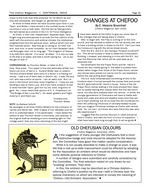 |
Page 19
“...this will counteract for them the softening influences of centrally-heated houses. Can you imagine Christmas holidays at Chefoo with central heat. No, nor can I, butthose who were there this year actually experienced it.
I suggest that the summer Reunion in 1934 should be held in Chefoo, and take the form of a tour of inspection. I shall have been back long enough then to act as guide.♦
OLD CHEFUSIAN COLOURS
(Chefoo Magazine, December 1935)
At the suggestion of many younger Old Chefusians that a more distinctive badge and crest should be adopted for the Association, the Committee have given this matter careful consideration.
While it is not usually desirable to make a change so soon, it was felt that a real up-to-date improvement could be effected by adopting for the Association an emblem which would be distinctive and have some definite pictorial reference to Chefoo.
A number of designs were submitted and carefully considered by the Committee. The final selection rested on one drawn by...”
|
|
| 20 |
 |
Page 20
“...The Chefoo Magazine
CENTENNIAL ISSUE
Page 20
World War II Years (1940-1945)
JAPANESE OCCUPATION
(Chefoo Magazine, July 1943)
Letters from Gordon Martin and the Misses
Broomhall, Stark, Woodward and Hills have given us close-up pictures of Chefoo, before and after the compulsory evacuation of our premises. Needless to say, the accounts are both jolly and pathetic, but the prevailing note in each is cheerful courage, deep thankfulness, and a ready recognition of God’s goodness in what were and are hard circumstances. Here are some extracts:
“For a longtime we expected to leave; one building after another was being commandeered and ‘visitors’ were always coming. We had to pick our way about the compound over new wires, holes, heaps and among buildings going up apace around us.
“Suddenly in the first week of November, sentries, posted at our gates, prevented anyone leaving. The same day, all foreigners outside the compound were ordered to Temple Hill. We thought we should be sent for the next...”
|
|